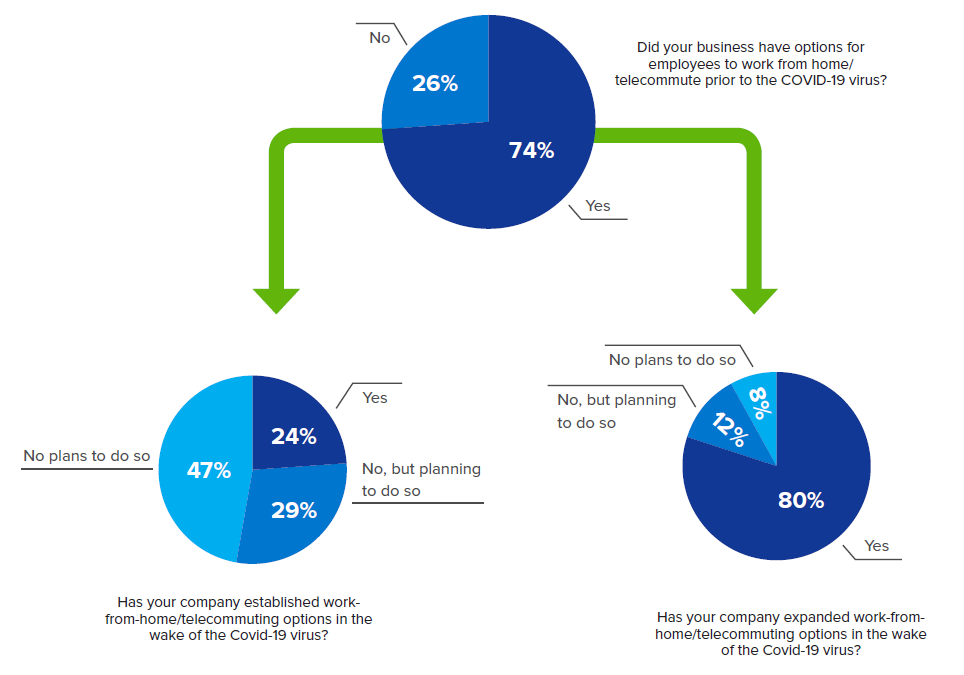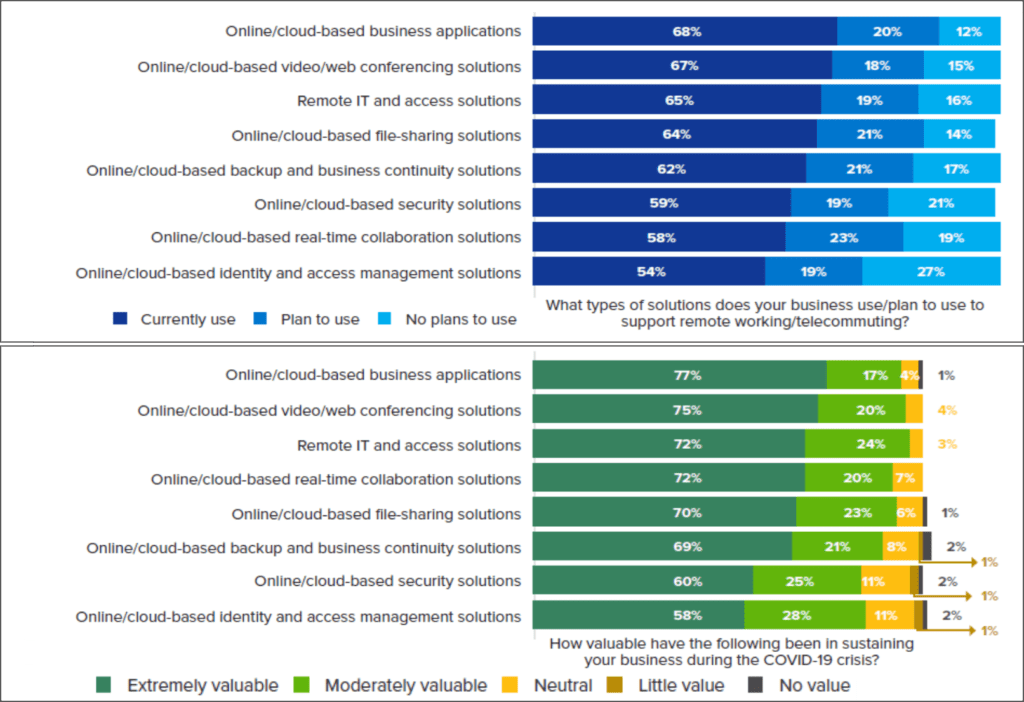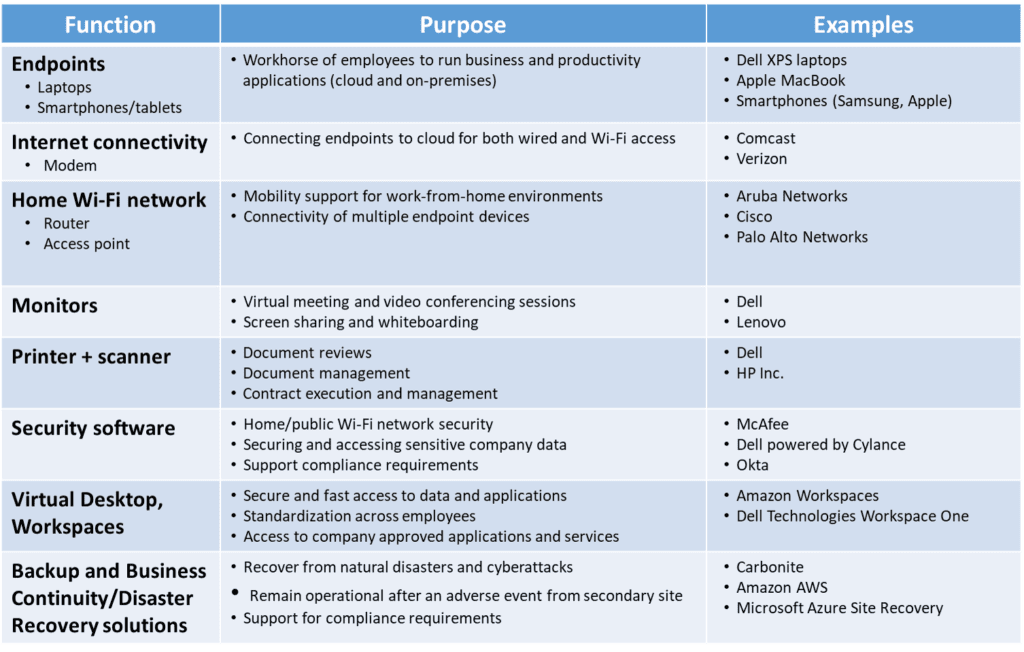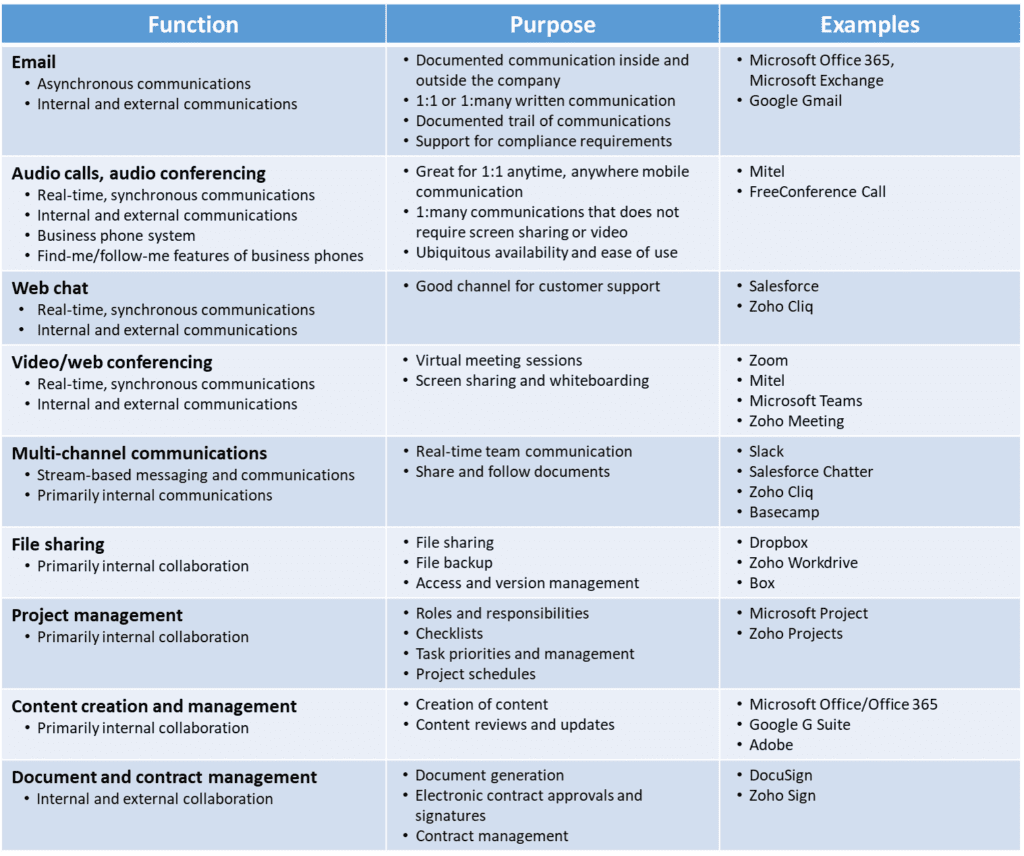The practice of working from home has skyrocketed in the wake of the COVID-19 crisis, as companies told their employees to stay home to comply with the widespread quarantine and social-distancing requirements. Small and medium businesses (SMBs) have had to coordinate a sudden and massive migration to work from home (WFH) for almost all of their employees, using collaboration tools in ways that are both productive and secure.
Companies are coming to terms with the “new normal,” which for now entails a large percentage of employees working from home. Consequently, SMBs are evaluating and re-imagining the infrastructure and tools required for this new path forward.
COVID-19, also known as the coronavirus, is having a devastating effect on SMBs—the engine of the U.S. economy and those around the world. How deep and broad is the impact? SMB Group sought to answer that question through a survey of more than 500 SMB and midmarket decision makers and influencers. Key findings include the following:
- A staggering 75% of all SMBs reported that COVID-19 is negatively impacting their business. 19% have not experienced a negative effect to date, and 6% are not sure of the effect on their business.
- As the economy reopens, working from home will be the new normal for most SMB employees. Therefore, SMBs must provide employees with the tools and resources that enable them to work productively and securely. The top solutions needed to support WFH employees include right-sized PC/endpoint devices, cloud-based business applications, video/web conferencing solutions and file-sharing solutions.
- Video/web conferencing and screen-sharing solutions saw a massive increase in adoption as all meetings, appointments and events moved to a virtual medium to ensure social distancing.
The abrupt departure from physical offices has forced SMBs to fundamentally change how they communicate, collaborate and manage employees, as well as how they communicate, collaborate and engage with customers. The next few sections explore these changes and their effect on SMBs.
SMBs Swiftly Canceled or Postponed Events and Meetings or Moved Them Online
In-person meetings, events and appointments have all but disappeared. According to SMB Group’s recent survey—The Impact of COVID-19 on SMBs (April, 2020), 71% of SMBs have already moved these activities from the physical world to the virtual one, and 16% are planning to do so.
But many activities can’t be easily, quickly or productively conducted online. After all, you can’t really cut someone’s hair, fix someone’s clogged drain or clean someone’s teeth during a video conference.


Source: The Impact of COVID-19 on SMBs (April, 2020)
Consequently, 72% of SMBs have postponed and 76% have entirely cancelled events, appointments and meetings in the wake of the pandemic.
Businesses in industries such as personal services, hospitality, home repair, construction, medical and dental practices, and others that rely on in-person activities to generate revenue will find it very difficult to recoup most of their lost income.
SMBs Double Down on Working from Home
Businesses that can do so are relying heavily on telecommuting to keep their operations going.
In SMB Group’s recent survey—The Impact of COVID-19 on SMBs (April, 2020), about three-quarters of SMBs reported having options in place for employees to work from home prior to the COVID-19 outbreak. In SMB Group’s 2019 SMB 360: Connecting the Dots Between Business and Technology Study, we found a similar percentage of SMBs offering telecommuting options. But in that survey, we also found that in the majority of companies, only a small percentage (1% to 10%) of workers were working remotely on a regular basis.
 Source: The Impact of COVID-19 on SMBs (April, 2020)
Source: The Impact of COVID-19 on SMBs (April, 2020)
As a result of new stay-at-home guidelines and mandates, however, 80% of SMBs with existing WFH programs are now expanding them as they try to keep their businesses going. Meanwhile, among SMBs that lacked telecommuting options prior to COVID-19, 24% have now established them, and 29% plan to do so.
Although there are bound to be fits and starts as companies adapt to their employees working from home, we believe that this shift will be a permanent one for many.
Online Solutions Play a Key Role in Sustaining SMB Operations
If there’s a silver lining in this crisis, it’s that online solutions are enabling many knowledge workers to work from home.
Fortunately, as reported in SMB Group’s recent survey, the majority of SMBs were already using many of the most vital solutions prior to the pandemic—with many more putting them in place to cope now that it has hit.
As important, these solutions are serving as lifelines for SMBs, with a majority rating the technology as extremely valuable in helping to sustain their companies during the COVID-19 crisis.


Source: The Impact of COVID-19 on SMBs (April, 2020)
In this survey, SMBs rated online cloud-based business applications, web/video conferencing solutions, remote IT and access solutions, and real-time collaboration as providing the most value in helping them to weather the storm.
Remote Work Is the New Norm—and It Is Here to Stay
In the COVID-19 era, working from home is the new normal. While the workforce has long been asking their employers for flexible work arrangements, WFH arrived in full force in the space of a few weeks. When workers across the globe were told to work from home in an effort to stem the coronavirus, what used to be a perk became an absolute necessity. However, the rapid transition to the entire workforce working from home is not the ideal way to implement and scale remote work at any company.
Their sudden departure from physical offices has forced SMBs to fundamentally change how they communicate, collaborate and manage employees and contractors. The case for remote work has been made, and returning to the office after this crisis won’t unmake it—for both employers and employees. Remote work is here to stay unless company results and data prove otherwise. Therefore, SMBs need to update and reimagine their technology solutions to enable employees to work productively and securely from home.
Reimagining the Portfolio of WFH Technology Solutions
Technology solutions for WFH employees can broadly be classified into two categories:
- IT infrastructure solutions
- Productivity, collaboration and business application solutions
These two types of solutions serve a different purpose, but collectively they enable the remote worker to productively and securely work from home to support business goals during these difficult and trying times.
Cloud-based digital tools that enable employees to work remotely need to be augmented with best practices, workflows and training to speed up adoption and compliance.
Table 1 – IT Infrastructure Solution Requirements

 Source: SMB Group, 2020
Source: SMB Group, 2020
Table 2 – Productivity, Collaboration and Business Application Solutions

 Source: SMB Group, 2020
Source: SMB Group, 2020
Security adds an extra layer of complexity to the remote working environment; employees must be provided the right tools and be trained in the best and safest practices in order to work from home productively. While investing in strong safeguards, businesses should make it easy for employees to comply with security requirements.
A strategic and well-orchestrated WFH program delivers company benefits including the following:
- Increased employee productivity and engagement
- Improved employee attraction and retention
- Reduced real estate costs (a traditional office-based workplace costs approximately $12,000 per employee, per year)
- Better environmental impact
Perspective
Whether a pandemic-driven immersion into remote working leads to a more permanent paradigm shift depends largely on whether the experience is a positive one for customers, employees and the SMB employers. Key considerations include:
- Update and standardize on tools, workflows and support required to work productively from home for an extended period of time
- Rethink how employees can better support customers with the tools and applications
- Enable working from home while supporting the required company security and compliance requirements
